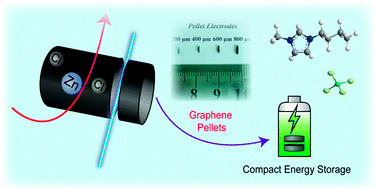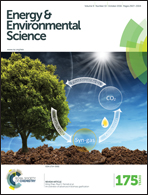Ultra-thick graphene bulk supercapacitor electrodes for compact energy storage†
Abstract
Compact energy storage with high volumetric performance is highly important. However, the state-of-the-art electrodes and devices remain far from the requirements due to the lack of consideration from a device perspective, which not only demands a high specific gravimetric capacity, but also needs to take into account operation voltage, material density and electrode thickness. We develop a novel approach to fabricate a monolithic ultra-thick and dense carbon electrode for symmetric supercapacitors, starting with graphene assembly and taking all the above factors into consideration. We found that zinc chloride is an ideal sacrificial pore former, and taken together with capillary drying can tune the specific surface area of the monolithic graphene from 370 to over 1000 m2 g−1 while the monoliths maintain a high density from 1.6 to 0.6 g cm−3. Having a good balance of porosity and density, the directly sliced graphene pellet electrode with a thickness up to 400 μm delivers a capacitance of 150 F cm−3 in an ionic liquid electrolyte, corresponding to a volumetric energy density of ∼65 W h L−1 for a symmetrical supercapacitor device, the highest value reported to date for supercapacitors. This study presents a design principle for electrode materials towards next-generation energy storage devices, not limited to supercapacitors, which are becoming smaller, lighter but more energetic.


 Please wait while we load your content...
Please wait while we load your content...